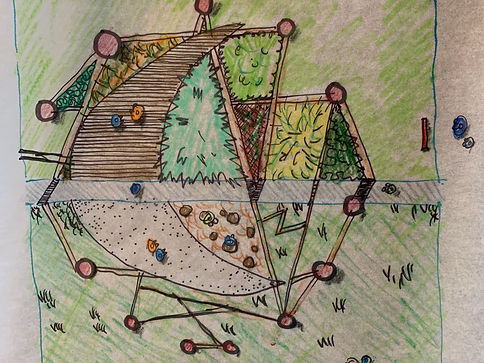THE MI’MAQI LUNAR GARDEN



Bringing Together Cultures and Seasonal Knowledge - The Mi’maqi Lunar Cycle
Before the arrival of Europeans, the native peoples of Canada and the Mi'Maqi used natural celestial and seasonal cycles to gauge the passage of time and organize their activities: (1) the rising and setting of the Sun governed the daily cycle; (2) over a yearly cycle, the variation of the day length and maximum elevation of the Sun drove the weather patterns and events in the natural world around them; and (3) in between the daily and yearly cycles, the Moon waxed and waned through its phases over a 30-day period.
This landscape art installation represents the Mi'Maqi lunar cycle and is organised to showcase educational knowledge of the 12 months and moons within the 4 seasons. This installation is a type of eco-calendar and brings together western scientific and indigenous wisdom through knowledge renewal and communication. This experience was developed through the method of Two-Eyed Seeing, whereby traditional aboriginal
knowledge and conventional science each guide the other towards a unified appreciation of the Moon Cycle. The small outdoor area provides interpretation about the Mi'Maqi culture and a place to walk and relax within nature.






A Collaboration among Students, Instructors, & Millbrook First Nation
This project was a multi-part development over 2 years. The initial idea begin with the abstract forms developed by Han Zie (2019). After discussions with Arthur Stevens at Millbrook First Nations, a conceptual design by Dr. Richard leBrasseur was re-configured and installed by Victoria Moffat (Class of 2022).
The names of the moon-times were intimately connected with the natural phenomena: Keptewiku's = 'freezing of rivers time' or November, and Nipniku's = 'trees fully leafed time' or June, for example. The First Nations' way of knowing was based on relationships and observations of natural phenomena and much of their life's activities revolved around these events and changes in the environment. The European way of knowing was based on the sciences of math, astronomy and physics andthe now common Gregorian Calendar which began in 1582 deviates from the true lunar cycle.






LOCATION
Agricultural Campus of Dalhousie University, Truro
At the corner of Sipu Awti and the lower parking lot for the Haley Institute Building, on the Cobequid Trail near the Hayley Institute.
Mi’kmaw place name:
Plamui-sipu, salmon river (Salmon River)
Coordinates: 45.371158, -63.262343
In 2016, River Road on Dal’s Agricultural campus was renamed to Sipu Awti (the Mi’kmaq translation) and The Mi’kmaq Grand Council Flag was permanently installed in recognition that the Campus sits on the traditional territory of the Mi’kmaq people. Historically, the Mi’kmaq lived along the banks of the Salmon River. In 1885, the province established the School of Agriculture, also on the banks of the river, and when the school started expanding the Mi’kmaq inhabitants of the area were relocated.
The lunar cycle is split into 4 primary moon phases as outlined by the various stones with the Moon cycle around it (12 months or moons).
There are 4 moon crescent shapes within the larger full-moon circle, each with different reflective materials.
The installation & walkway layout intersects the lunar circle at the curvature angle or path of the Annual Solar Eclipse (June 10/11).
The annual lunar cycle is expressed in 12 wood signs with the Mi Magi name and English translation for the moons of the Mi'Maqi calendar.
The large vertical Elm functions as a sun dial and can be used to estimate the time.
The shiny leaved plant species were used for medicinal purposes by the Mi'Maqi.

Interestingly, how has global warming changed these seasonal events?
Does lower Canada have freezing ponds and lakes in November anymore?
How have humans changed the landscapes you live, work and play in?
What was the floodplain landscape of the Bay of Fundy like 400 years ago?
There is much to be learned from indigenous knowledge to help us create resilient sustainable landscapes and communities as we continue to respond to the impacts of climate change.
THE GREEN INFRASTRUCTURE PERFORMANCE LAB
The Green Infrastructure Performance Laboratory
Director, Richard leBrasseur, PhD
Dalhousie University
Department of Plant, Food, and Environmental Sciences
20 Rock Garden Road, EE Building, Room 223
Truro, Nova Scotia, Canada B2N 5E3




